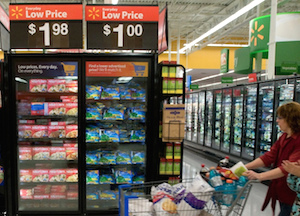There was a time when dual merchandising (the siting of your product in a secondary location in a store, in addition to its usual place) was something that every trade marketer or shopper marketer dreamt of. Over the years significant funds have been spent and wasted on getting products to another location in a store. And whilst secondary siting can be a useful strategy under a certain set of circumstances, too often effort is wasted. So when considering shopper marketing tactics, how can shopper marketers decide if a secondary location in store would help their brand and if so, where should it be located?
Getting secondary locations wrong can be an expensive mistake
Secondary location or merchandising is typically expensive. Retailers (in their minds) are giving up more precious real estate without creating significant extra value for their shoppers (the range on offer hasn’t increased, so the shoppers haven’t any additional selection). The retailer will have to hold more inventory, which is expensive, and managing inventory across two locations is hard: stock levels are often recorded at a total store level, so a product in-stock at one location and out of stock elsewhere, would record as in-stock overall and the shelf might remain empty – bad news for shoppers and the retailers who are courting them. And that can be bad news for the brand too. Loyal shoppers visiting the home shelf may find the brand out of stock, and that might be all that it takes to tempt them to try a competitor brand.
Selecting shopper marketing tactics starts with the target shopper
Merchandising is about making products available and visible to the shopper. It therefore stands to reason that a secondary location is going to be more effective against shoppers who would not normally visit the main category space. If the goal is to put the product in front of the shopper, then if a marketer’s goal is to gain share, then they know that the shopper will almost certainly visit the category anyway – so why not market to them there? If however, the shopper isn’t in the category already, then they arguably won’t visit that part of the store, and a secondary location may be essential
Shopper marketing tactics are all about location, location, location
The next part of the process is straightforward: identify parts of the store where the target shopper will go. If you market steak sauce, and you are targeting shoppers who buy steak but don’t use the sauce, then logically those shoppers can be found at the meat counter. If the product was targeting vegetarians, then that might be the last place in the store to put your product.
But alas, if only it was that simple. If all we had to do was put the product in the path of the shopper, the whole concept would be really simple. We could target high traffic locations (this is why getting space at the check-out is so competitive – all shoppers go there!) – but just because your target shopper is there, doesn’t mean that they are going to notice or engage with your brand.
 To ensure we connect with shoppers, marketers must consider the shopping mission the shopper is engaged with at the time. The shopper is connected to their shopping, and to the consumption occasion that they are serving. In the example below head-ache solutions are placed next to tonic water (I assume it isn’t allowed to place medicine into the alcohol section) – attempting to make a connection between the consumption of alcohol and the subsequent risk of a headache. If this is built on an insight that driving this purchase will drive further consumption (because too many hangovers go untreated due to a lack of analgesics) then they may be on to a winner.
To ensure we connect with shoppers, marketers must consider the shopping mission the shopper is engaged with at the time. The shopper is connected to their shopping, and to the consumption occasion that they are serving. In the example below head-ache solutions are placed next to tonic water (I assume it isn’t allowed to place medicine into the alcohol section) – attempting to make a connection between the consumption of alcohol and the subsequent risk of a headache. If this is built on an insight that driving this purchase will drive further consumption (because too many hangovers go untreated due to a lack of analgesics) then they may be on to a winner.
Consider a blend of shopper marketing tactics
A secondary location creates a different availability to the shopper, but that might not be enough to convert a sale. An effective  shopper marketing mix needs to consider availability together with communication and offer. Consider which product to merchandise in the secondary location (if we are driving trial, then perhaps a small pack). Consider if a promotional deal may be required. And consider whether any message needs to be communicated to seal the deal. In the example below Sensodyne (a toothpaste for sensitive teeth) is nicely merchandised above the ice cream freezer – connecting a very visceral experience of sensitive teeth for many. But the shopper marketing team seem to believe that in this market and channel (this is in Vietnam) shoppers will need further education on the benefits of Sensodyne and have therefore included more detailed communication.
shopper marketing mix needs to consider availability together with communication and offer. Consider which product to merchandise in the secondary location (if we are driving trial, then perhaps a small pack). Consider if a promotional deal may be required. And consider whether any message needs to be communicated to seal the deal. In the example below Sensodyne (a toothpaste for sensitive teeth) is nicely merchandised above the ice cream freezer – connecting a very visceral experience of sensitive teeth for many. But the shopper marketing team seem to believe that in this market and channel (this is in Vietnam) shoppers will need further education on the benefits of Sensodyne and have therefore included more detailed communication.
Secondary locations can be highly effective, especially when targeting shoppers who would not normally visit the category, but they are expensive and can lead to out of stocks on the home shelf, which might disappoint regular shoppers and persuade them to try a competitor. But by carefully considering which brands, in which stores might benefit from secondary locations; and by executing a considered marketing mix which overcomes all of the barriers to purchase that the target shopper might have, secondary locations can be one of the most effective shopper marketing tactics.
I will continue this series of blogs on shopper marketing tactics over the next few months: to ensure you don’t miss any of them, please subscribe to the blog.



